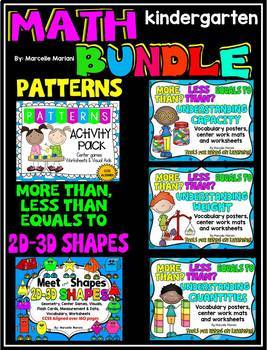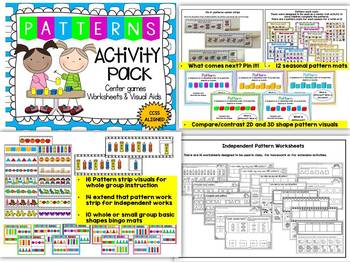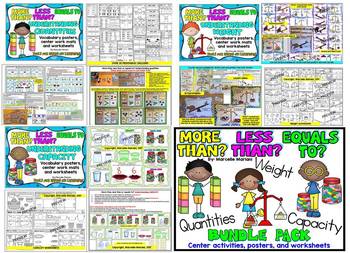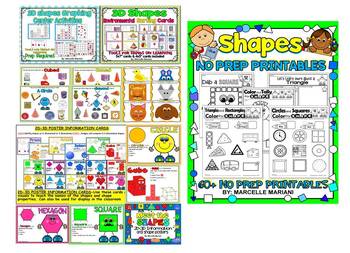More than-less than, 2D, 3D shapes, Patterns- MEGA MATH BUNDLE
- Zip
What educators are saying
Products in this Bundle (4)
Description
This bundle pack is over 500 pages of Math and Geometry teaching resources and covers More than-less than (quantities, capacity and weight), patterns and 2D and 3D shapes.
PLEASE REFER TO THE LINKS BELOW TO VIEW EACH OF THESE PACKETS INDIVIDUALLY AS I WAS UNABLE TO INCLUDE ALL THE TOOLS IN THE THUMBNAILS IMAGES DUE TO THE UPLOAD SIZE LIMIT
More than-Less than-heavier than-lighter than-Holds more-holds less Pack
The activities in these packages provide hands-on learning.
2D-3D BUNDLE INCLUDES THE FOLLOWING:
2D and 3D shapes-informaiton vocabulary visuals
K.G.A.3-Identify shapes as 2 dimensional or 3 dimensional
K.G.B.4– Analyze and compare 2-3 dimensional shapes
A. 6-3D Full size information/vocabulary cards
B. 7-2D Full size information/vocabulary cards
C. 6-3D Shape character vocabulary flash cards
D. 7-2D shape character vocabulary flash cards
E. 11-2D shape pictures-Flash cards
F. 8– Black and white shape pictures
Use these cards as visuals to teach the names of the shapes and shape properties (2D/3D, numbers of sides, and number of corners)
Use these cards for display– on boards and as visuals of 2-3D shapes
Use the 2 D shape pictures as a group game to get children to discuss what they see, what shapes the picture is composed of, how many shapes, what colors?
Included are also black and white shape coloring sheets– You can have children choose their own colors or color according to the colored flash card model.
Sorting environmental cards 4'x6'
A. 16-Environmental comparison cylinder cards 4’x6’
B. 14-Environmental comparison cube cards 4’x6’
C. 14-Environmenatl comparison cone cards 4’x6’
D. 10-Environmental comparison pyramid cards 4’x6’
E. 6– Environmental comparison sphere cards 4’x6’
Use these cards to make direct comparison between the shape and the object reflecting on specific properties (number of sides, number of faces, vertices, if the object rolls or slides)
Sorting environmental cards 13cmx11cm
A. 72- Environmental small cards showing items in the environment
B. 7- 3d Shape title cards
3D shapes- environmental cards
-Identifying shapes as 2 dimensional (plane) or 3 dimensional (solid) (K.G.A.3)
-Analyze and compare 2-3 dimensional shapes (K.G.B.4)
-Describe measurable attributes of objects such as length or weight of a single object (K.MDA.1)
-Directly compare two objects with a measurable attribute in common (more than, less than, taller/shorter)
K.MD.A.2
-Classify objects into given categories; count the number in each category and sort categories by count (K.MD.B3)
These cards are designed for young children to identify 3D shape in real life objects. Here are some suggestions:
Use these cards during group discussion times to talk about the shapes and to compare the shapes to each other– this means identifying similarities and differences in their structure (K.M.D.A.1)
You can place the title cards and have children sort the pictures by shapes. (k.MD.A.1)
You can have children count the shapes after they are all sorted in a row or column and identify which shape has more image/pictures (K..MD.B.3)
Use these cards on a display/teaching board
You can use the title cards as headings to sort real objects you have in class or in the house (K.MD.A.1) and you can extend that by asking children to count how many of each shape we have at home/in class (K.MD.B.3)
3D Shapes Graphing
These cards are designed for young children to identify 3D shape and interpret data to graph and sort 3D and 2D objects
There are variations to the graph below
1-Generic graph- Color- (1-5) where children interpret data from a 3D data card and graph accordingly (5 cards+75 graph cards)
1-Graph-Black and white- (1-5)
1-Graph- Adaptable to 1-10 (Color)
1-Graph-Adaptable to 1-10 (Black and white)
20 graph cards (numbers 1-20)
30- graph 3D cards
5-3D shapes data cards
75 small graph 3D cards to go with the data cards
6-3D graphing guide cards
60-small graph 3D cards t go with graphing guide
Graphs are adaptable to be used with real objects
Environmental comparison cards 8.5x11
6 -Large 8.5 x 11 comparison cards/mats
Use these cards as during group lessons/discussions about shapes– Ask children to identify and compare the shapes on the cards . Every card targets a different shape– children need to locate all the items on the card that are the same shape as the one in the circle.
These can also be used as work mats– laminate and use a board marker to have children circle the shapes-Great center activity for younger children
3D shapes nets
A. 1-Net information definition/information card
B. 2– Net to shape identification visual mats– problem solving
C. 1– Net to shape identification visual display/teaching mat
D. 6-Reprodicible Shape nets– To assemble 3D shapes
Children can assemble the nets and compare them to each other and real objects
Children can make multiples of each net and use them to build larger shapes and structures (taller cylinders and cube towers)
worksheets
16 different worksheets to target understanding 2D and 3D shapes
MORE THAN-LESS THAN PACKET INCLUDES:
(K.MD.A1, K.MD.A2, K.MD.A3, K.MD.B.3, K.CC.A3, K.CC. B4, K.CC.B5, K.CC.C6)
The package is organized into 3 sections
SECTION 1- QUANTITY
• MORE THAN, LESS THAN, EQUALS TO (QUANTITIES) POSTERS, VISUALS, WORKMATS AND CENTER TOOLS
Lesson Objectives
• How to describe and directly compare objects by attributes (CCSS.K.MD.A.2)
• Problem Solving– Analyzing, reasoning and interpreting attributes
• Describing measurable attributes of objects (quantity) (CCSS.K.MD.A.1)
• Using tools to model and make direct comparisons to investigate and problem solve.
• Counting to say how many and draw comparisons with quantities (CCSS.K.CC.C.6, CCSS.K.CC.B.5)
INDIVIDUALLY POSTED CENTER MORE-LESS-EQUAL TO QUANTITIES ACTIVITIES
more than-less than-equals to, pin it strips and direct comparison work mats- birdie style
More than, less than, equals to-pin the correct symbols task cards and strips-sea life style.
MORE-LESS-EQUALS TO QUANTITIES-TEACHING POSTERS
• 4 X posters comparing quantities and teaching the more than, less than and equals to symbols
• 1 x quantity definition poster
• 1 x equals to comparison poster that teaches the sign of equals to
MORE-LESS-EQUALS TO QUANTITIES-DIRECT COMPARISON MATS
• 11 X Direct comparison work mats- full page size- designed to be used with the enclosed labels (more than, less than, equals to or same as)
• 5 x Compare the groups direct comparison mats that use ten frames- students count the objects in each frame and use the correct symbol in the middle to make it true
• 2x Compare the groups direct comparison mats that use BLANK ten frames- students identify the symbols and represent using objects
• 3x Compare the groups direct comparison mats that have the symbols in the middle with blank ten frames. Students identify the symbol and use objects in the frames to make it true
• 1x Completely blank work mat with blank ten frames and blank center so students can add the symbols and objects
• 5 x direct comparison mats designed to be used with the enclosed quantity cards and math symbols
• 12 x apple quantity cards counting from 1-12
• 12 x blueberries in a basket quantity cards counting from 1-12
• 12 x bananas in a bunch quantity cards counting from 1-12
• 12 x flower in a vase quantity cards counting from 1-12
• Small cards showing numbers 1-20 to compare numbers
• 3 x fish and bowls direct comparison mats (showing a fish with an open mouth and two bowls- use with objects to show more than, greater than and equals to using fish snacks or fish counters)
MORE-LESS-EQUALS TO QUANTITIES-INTERACTIVE POWERPOINT
• Each slide shows two kids holding a jar with different number of beans. Students drag and drop the symbols to show which student is holding more than, less than or if the jars have an equal quantity.
MORE THAN, LESS THAN, EQUALS TO (QUANTITIES) 49 WORSHEETS
• Count the spots on the ladybug. Cut and paste the correct alligator mouths to show which ladybug has more dark spots
• Name the number on the hat each child is wearing. Color that many circles in the frame each child is holding. Cut and paste the alligator mouth to show which child shows more.
• I can compare the sets- Draw a line from each object in the first set to another object in the second set. Which has more?
• I can compare the sets- Draw a line from each object in the first set to another object in the second set. Which has less?
• 2x I understand the symbols that show more than, less than and equals to
• 3x I understand the symbols that show more than, less than and equals to (differentiated- larger coloring and only one set of groups to compare)
• 2x I can label to show more than or less than (cut and paste the labels)
• Name the number on the hat each child is wearing. Color that many circles in the frame each child is holding. Cut and paste the alligator mouth to show which child shows more (BLANK and LARGER so you can write your own numbers from 1 to 10)
• Work it out! Which fish bowl shows more? Name the number on the fish bowl. Draw, paste of stamp to show this amount. Cut the fish mouths and paste to show which bowl shows more.
• Compare the candy jars. Cut and paste the correct alligator mouths to show which jar shows more candy.
• Compare the candy jars. Cut and paste the correct alligator mouths to show which jar shows more candy (differentiated- larger jars and cutting)
• I can draw to show more than and less than- Make it true- draw or paste in the plates to show which plate shows more/less
• I can show the same amount- draw, paste or stamp in the plates to show that both plates are equal.
• I can draw the correct symbol to make it true- count and tally the flowers in each pot. Write the number that says how many. Write the correct symbol to show which is more or less.
• Work it out to show more or less (comparing numerals and using drawings and objects to work it out and represent using the correct math symbol)
• 3x Work it out to show more or less (comparing numerals and using drawings and objects to work it out and represent using the correct math symbol)- differentiated- larger and targets one comparison
• Draw, paste or dot objects into the jars to make them equal- write the symbol that says ‘equals to’ between the jars.
• Compare the groups- which set shows more objects? Circle the set that shows more
• Compare the groups- which set shows less kids? Count and record the number and color the group of kids that show less than the other.
• Explore and explain- draw to show more or less according to the labels
• Draw to show that the fish is eating more
• I can identify two groups out of 3 with the same quantity
• Compare the families- which family shows fewer members?
• Which gumball machine shows the least amount of gumballs?
• 2x Compare the groups- draw a line from objects in one group to objects in the other group to show which group has more
• Compare the groups- draw a line from objects in one group to objects in the other group to show which group has the least number of objects
• 2 x compare the groups- look at 4 sets of quantities and color the two sets that show the exact same quantity
• Compare the groups. Circle the correct math symbol < = or > to make it true.
• 2x draw of paste objects in the boxes to show that the shark is eating more.
• Draw of paste objects in the boxes to show that the fish is eating more
• Compare the groups- which group shows more fish in the bowl? Circle the correct math symbol to make it true
SECTION 2-WEIGHT (HEAVIER/LIGHTER)
• MORE THAN, LESS THAN, EQUALS TO (WEIGHT) POSTERS, VISUALS, WORKMATS AND CENTER TOOLS
Lesson Objectives-More than, less than or equals to? Understanding WEIGHT
• How to describe and directly compare objects by attributes (CCSS.K.MD.A.2)
• Problem Solving– Analyzing, reasoning and interpreting attributes
• Describing measurable attributes of objects (weight– visually and using objects to count) (CCSS.K.MD.A.1)
• Using tools to model and make direct comparisons to investigate and problem solve.
• Counting to say how many and draw comparisons with weight (7 strawberries will weigh more than 3 strawberries) (CCSS.K.CC.B.5)
MORE-LESS-EQUALS TO WEIGHT-TEACHING POSTERS
• 1 X SEE-SAW version poster- teaching definition of weight
• 1 X SEE-SAW version poster- teaching vocabulary of heavy and light
• 1 X SEE-SAW version poster- teaching vocabulary of heavier and lighter
• 1 X SEE-SAW version poster- teaching vocabulary of heavier than
• 1 X SEE-SAW version poster- teaching vocabulary of lighter than
MORE-LESS-EQUALS TO WEIGHT-DIRECT COMPARISON WORK MATS
• 6 x animal labeling see saw mats- which animal is heavier- use the labels to label heavier than or lighter than
• 2 x animal modeling see saw mats- use with the animals included to model and show which animal is heavier or lighter on a see saw and use the labels to label heavier than and lighter than
• 27 x animals of different sizes and weights- these are to be cut, laminated and used with the see saw mats to represent heavier than and lighter than
• 1 x SCALE version poster- teaching definition of heavier and lighter
• 3x SCALE labeling mats- scales show specific quantities- students use the labels to label the scale baskets to show which is heavier and which is lighter
• 3 x SCALE mats that are BLANK and have a square to insert the quantity basket cards that come separately- student represent heavier than and lighter than using quantity scale basket cards
• 12 x scale balance basket quantity cards showing quantities to 12- carrots
• 12 x scale balance basket quantity cards showing quantities to 12- grapes
• 12 x scale balance basket quantity cards showing quantities to 12- blueberries
• 12 x scale balance basket quantity cards showing quantities to 12- apple
• 12 x scale balance basket quantity cards showing quantities to 12- strawberries
• 12 x scale balance basket quantity cards showing quantities to 12- jellybeans
• Label strips: heavier than, lighter than, same as, equals to
• 3 x SCALE-PLATE STYLE blank mats to be used with objects to draw direct comparisons.
MORE THAN, LESS THAN, EQUALS TO WORKSHEETS (WEIGHT)
• Is it light enough to lift? Color all the objects that are light enough to lift
• I can understand and show weight (balance scale version)- cut and paste fruits into the scale to make the scales true (art activity)
• I can understand and show weight (see saw version)- cut and paste animals on to the see saw to show which animal is heavier/lighter
• 2x Which is the heaviest? Color the heaviest item in each group
• Lighter than- circle the item that is lighter than the item in the first box
• 2x identifying and labeling on a balance scale (write lighter or heavier to show)
• 2x Heavy or light? Identify, cut and paste to label
• 2x Heavier or lighter? Identify, cut and paste to label
SECTION 3-CAPACITY (HOLDS MORE/HOLDS LESS)
• MORE THAN, LESS THAN, EQUALS TO (CAPACITY) POSTERS, VISUALS, WORKMATS AND CENTER TOOLS
Lesson Objectives-More than, less than or equals to? Understanding CAPACITY
• How to describe and directly compare objects by attributes (CCSS.K.MD.A.2)
• Problem Solving– Analyzing, reasoning and interpreting attributes
• Describing measurable attributes of objects (capacity– visually and using objects to assess) (CCSS.K.MD.A.1)
• Using tools to model and make direct comparisons to investigate and problem solve.
• Counting to say how many and draw comparisons with capacity (1 cup will hold 100 pom poms, 1/2 cup will hold 50 pom poms) (CCSS.K.CC.B.5)
MORE-LESS-EQUALS TO: CAPACITY-TEACHING POSTERS
• 1 X reasoning poster- which jar can hold this many jellybeans
• 1 x capacity definition poster showing two jars with jellybeans and labeled with ‘holds more’ and ‘holds less’
• 1 x ‘holds less’ definition poster
• 1 x ‘holds more’ definition poster
• 1 x ‘holds the same as’ or ‘equals to’ definition poster
MORE-LESS-EQUALS: TO CAPACITY-DIRECT COMPARISON WORK MATS
• 7 X mats that show two different empty containers on the page (jars, baskets, plates, glasses, etc..)- students use objects to model which container holds more or less and then use the enclosed labels to label the containers with ‘holds more’ or ‘holds less’.
MORE THAN, LESS THAN, EQUALS TO WORKSHEETS (CAPACITY)
• In each set color the item that can hold the most number of items
• In each set color the item that can hold the least number of items
• Problem solve! Draw a line from the bunch of strawberries to the plate that will best fit the bunch without room to spare.
• Color the container in each set that can hold the greatest number or objects.
• Color the item that can hold the least number of objects in each set.
• Draw a container that can hold more than the container shown.
• Cut and paste the group of apples to fit into the correct basket.
PATTERNS PACKET INCLUDES:
6- full color pattern visual concept cards- to use as display and teaching visuals
14- Pattern mats- What comes next?- To use during group or to explain patterns
10- Pattern mats- Extend the pattern mats-To be used as a center activity
20- Pattern cards- to be used with the center activity to extend the pattern
2- black and white- labeled with A and B-reproducible mat- print and copy as needed- can be laminated and used with objects or as a worksheet
2- Full sheet of A, B strips- to be used with pattern mats- Copy the A and B strips on different colors- cut and laminate- use with pattern mat
1- Blank full size pattern mat- color- Print and laminate as needed
6- Quantity sequence mats- Print and laminate- Children match the number strips to the correct quantity sequence
6- Number strips- to be used with quantity sequence mats or independently with objects
1-Quantity sequence blank mat- can be used with objects and number strips- print and laminate as needed
1-pattern mat sample- black and white-print, copy on colored paper and laminate as needed
12 pattern worksheets
If you have any questions, please contact me at marcellemariani@gmail.com
Enjoy
Marcelle





